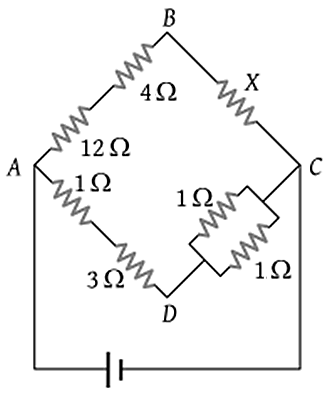The circuit shown contains three identical resistors, two ammeters X and Y, and a voltmeter Z. The internal resistance of the battery is negligible.

Which option shows the readings on the three meters?
(Assume the ammeters have negligible resistance, and negligible current flows through the voltmeter.)
1.
X = \(1.0\) A; Y = \(0.0\) A; Z = \(12\) V
2.
X = \(2.0\) A; Y = \(0.0\) A; Z = \(4.0\) V
3.
X = \(1.0\) A; Y = \(2.0\) A; Z = \(8.0\) V
4.
X = \(3.0\) A; Y = \(6.0\) A; Z = \(12\) V

Which option shows the readings on the three meters?
(Assume the ammeters have negligible resistance, and negligible current flows through the voltmeter.)
A student has three \(6.0~\Omega\) resistors that can be connected together in any configuration. What are the maximum and minimum resistance that can be obtained by using one or more of these three resistors?
(Assume the connections between the resistors have negligible resistance, the temperature of the resistors is constant, and the resistors are used in a d.c. circuit and none of the resistors are shortcircuited.)
| 1. | maximum resistance: \(12~\Omega\); minimum resistance: \(0.50~\Omega\) |
| 2. | maximum resistance: \(6.0~\Omega\); minimum resistance: \(0.50~\Omega\) |
| 3. | maximum resistance: \(18~\Omega\); minimum resistance: \(6.0~\Omega\) |
| 4. | maximum resistance: \(18~\Omega\); minimum resistance: \(2.0~\Omega\) |
Three resistors are connected to a \(20\) V battery with a constant supply. One of the resistors is a variable resistor. The resistance of the variable resistor is gradually increased from zero to \(5\) \(\Omega.\)
Which graph shows how the current from the battery varies with the resistance \((R)\) of the variable resistor?
| 1. |  |
2. |  |
| 3. |  |
4. |  |
A battery of internal resistance r, when connected across \(2~\Omega\) resistor supplies a current of 4 A. When the battery is connected across a \(5~\Omega\) resistor, it supplies a current of 2 A. The value of r is:
| 1. | \(2~\Omega\) | 2 | \(1~\Omega\) |
| 3. | \(0.5~\Omega\) | 4. | Zero |
In the circuit shown in the figure below, the current supplied by the battery is:
1. 2 A
2. 1 A
3. 0.5 A
4. 0.4 A
The equivalent resistance between points A and B in the circuit shown in the figure is:
1. 6R
2. 4R
3. 2R
4. R
In the circuit shown in the figure below, if the potential difference between B and D is zero, then value of the unknown resistance X is:
| 1. | 4 Ω | 2. | 2 Ω |
| 3. | 3 Ω | 4. | EMF of a cell is required to find the value of X |
The figure below shows a network of currents. The current \(i\) will be:
1. \(3~\mathrm{A}\)
2. \(13~\mathrm{A}\)
3. \(23~\mathrm{A}\)
4. \(-3~\mathrm{A}\)
Eels are able to generate current with biological cells called electroplaques. The electroplaques in an eel are arranged in 100 rows, each row stretching horizontally along the body of the fish containing 5000 electroplaques. The arrangement is suggestively shown below. Each electroplaques has an emf of 0.15 V and internal resistance of 0.25 Ω.
The water surrounding the eel completes a circuit between the head and its tail. If the water surrounding it has a resistance of 500 Ω, the current an eel can produce in water is about:
1. 1.5 A
2. 3.0 A
3. 15 A
4. 30 A
An electric heater consists of a nichrome coil and runs under \(220\) V, consuming \(1\) kW of power. Part of its coil burned out and it was reconnected after cutting off the burnt portion. The power it will consume now is:
| 1. | more than \(1\) kW |
| 2. | less than \(1\) kW but not zero |
| 3. | \(1\) kW |
| 4. | \(0\) |








